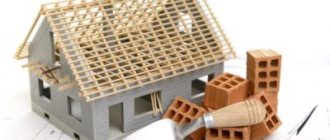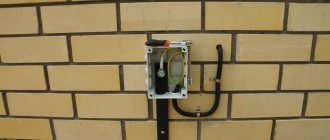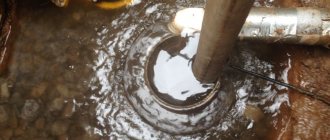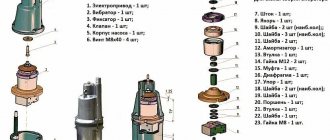Having purchased a country plot, the owners are faced with the need to equip a well. In order for this facility to comply with sanitary and hygienic standards and be safe during operation, it is important to choose the right location for the construction of the mine.
A reader contacted our editorial office who was faced with a similar problem: “I bought an inexpensive plot of land that did not have a centralized water supply. To provide the country house with water, I thought about building a well. I read on the Internet that you need to choose the right place to drill a well. I have a plot of rather modest size, on which a small house is built, and there are outbuildings. How to determine the optimal location for building a well?
We often receive similar questions. We have studied the topic and will provide comprehensive answers to readers’ questions. Next, we will consider the basic legal requirements, building codes and rules regulating this process.
It is advisable to plan the construction of a well before the construction of any objects on the site begins. However, more often it turns out, as in the case of our reader, that the house has already been built and the plot has outbuildings. What to do in this case? You need to carefully consider the site plan. When choosing a location to create a well, the ease of use of the facility is taken into account. It is important that the water intake point is located at an appropriate distance from sources of pollution, as well as other objects.
The well should not interfere with travel or cause damage to nearby objects, including other wells and neighbors’ buildings.
Legal norms
When building a well on a private plot, the requirements of the following legislative acts are taken into account:
- SNiP 30-02-97. This document has been updated in 2021. Now, when constructing wells with water consumption of more than 100 cubic meters per day, it is necessary to register the facility, obtain a license and pay taxes. SNiP specifies recommendations for the construction of facilities on the site. The local administration of SNT or another type of partnership specifies in the regulations the relevant requirements for the location of facilities. When drawing up the charter, the recommendations of SNiP are taken into account.
- SP 53.13330.2011. This guide allows you to determine the correct location for the well on the site diagram. It is used during the development of an allotment plan before the construction of residential and commercial facilities begins.
- SP 31.13330.2012. These rules regulate the construction of sanitary facilities on your own site.
Most often, shaft wells are created in suburban areas. They are built taking into account the water source on the neighboring site. The work of choosing a place to build a well should be entrusted to a specialist . If you do not take into account the depth and volume of the neighbors' water intake point, after construction the water may go into a new well. This will lead to disputes with neighbors. They will win the case in court, and your well will be closed at your expense. Therefore, it is worth carefully approaching the process of choosing a water intake point.
Video review:
Everything useful about sewerage - gidkanal.ru GidKanal | Yandex Zen
Communication systems are a mandatory attribute of every living space. The successful functioning of engineering communications is laid down at the design stage, and ignorance of the specifics of the relative position of individual systems or their components can lead to troubles, even to catastrophic consequences.
The content of the article:
Photo for the article.
[my_custom_ad_shortcode5]
Ideal location
Owners of suburban areas have to follow a whole set of rules when placing allotment objects. It is especially difficult for owners of narrow and small areas to choose the optimal location for drilling a well. An ideally located well should:
- Be located at a sufficient distance from the foundation so as not to cause the destruction of the house due to erosion of the foundation.
- Don't disturb your neighbors.
- Don't be too far from home. Otherwise, a complex communications system will be required, which will be expensive and will become clogged.
- Keep at a sufficient distance from sources of pollution.
- Do not interfere with travel, passages, trees, or garden crops.
- Stay away from the road.
- Be higher than the level of the septic tank (cesspool) on your own and neighboring plots.
- Keep away from objects on the site at the distance established by SNiP.
It is sometimes very difficult to comply with all the requirements. If you can find a suitable place to drill, there is not always water there. This makes finding a suitable location a difficult process.
Rotary wells for sewerage
This type of wells in its purpose and design is absolutely identical to inspection wells, with the only difference being that rotary wells are installed in places where the direction of the pipeline changes. Sharp bends with large turning angles are usually the areas most likely to become clogged and require special attention. This is precisely the function that rotary wells perform.
The distance between rotary sewer wells is usually calculated based on the length of the straight sections between the bends of the pipeline. If the pipeline section is longer than specified by the regulatory document, then it must be equipped with inspection wells in order to ensure a sufficient level of control over the operation of the system.
Distance from foundation
It is easier to choose the optimal location for building a well shaft when the house has not yet been built. If the building already exists, it is worth considering the type of foundation. Shallow foundations of houses are especially affected by the proximity of a well shaft. If the building is built on a strip foundation on clay, the well is made as far as possible.
In accordance with SNiP 30-02-97, the minimum distance from the well to the base of the house is 3 m. But it is better to build a well at a distance of up to 5 m.
This safety measure is necessary, since after digging a mine, the water rises 1.5-2 m relative to the aquifer. Therefore, wells of shallow depth will be the most problematic during operation. Such mines are located in areas where groundwater comes close to the surface. After constructing a well shaft, flooding may occur. The water level will rise and will seep through the walls of the mine.
This leads to erosion of the foundation. Over time, it will collapse, which entails the most undesirable consequences for the building. It is not safe to live in such a house. The well shaft must be properly sealed. It is best to use reinforced concrete rings in this case. When using stone, brick or wood to build a mine, you need to choose high-quality materials for sealing.
Methods for laying underground networks
Collectors, tunnels and channels are used to extend underground utilities in civil engineering; in households, ditches dug in the soil are used to lay pipelines. If digging trenches in an open manner is not possible, trenchless pipe laying is carried out by drilling, piercing or pushing the soil with hydraulic jacks. Abroad (in Germany), an effective method of laying pipes is widely used using special equipment that cuts a trench and simultaneously immerses a polymer pipeline into it.
Based on the method of arrangement of communications in trenches, the following are considered:
Separate method. During installation, each highway is installed in its own channel; the method is expensive when laying a large number of nearby communications.
Collaborative method. According to SNiP 2.07.01-89, in common trenches it is allowed to lay heating mains measuring from 50 to 90 cm, water supply up to 50 cm, more than 10 communication lines or power electrical cables with a voltage of up to 10,000 volts, if there is not enough space for laying lines in individual trenches plot.
It is allowed to lay water pipelines in tunnels with other communications (SNiP 2.04.02-84) except for pipelines carrying combustible and flammable media.
When laying pipeline fittings in the ground, they are placed in technical wells.
If wells or boreholes are used on the site, from which an underground pipeline is laid to transport water to the house, the minimum depth of the water supply system is taken equal to the lowest freezing point of the soil in the given area with the addition of 0.5 m. A layer of soil on top to avoid unwanted heating of water in the pipes in summer leave at least 50 cm.
Rice. 3 Drilling underground utilities with a German pipelayer
Alternative solution
If the house has not yet been built, you can make a well directly in the building. This solves the problem of removing the well from different objects. The interior layout of the house must be properly designed. The well must be located at an appropriate distance from the foundation.
This solution allows you to save space on the site and reduce the cost of installing a water supply system. First, a well is created on the site, and then a foundation pit is dug. The type of soil and topographical features of the area are taken into account.
The advantages of such a solution are comfort when arranging a communication system for supplying water to a bathroom, toilet, or kitchen. A minimum number of pipes and a pump with less power will be required. This reduces the cost of installing a water supply system.
Building a well inside a house also has a number of disadvantages. For example, if the water supply equipment breaks down, the well needs to be repaired. This may require special equipment that cannot be used in a basement. To periodically clean the shaft, you need to provide sufficient space around the well. Finishing materials in the basement must be resistant to moisture.
Also, building a water intake point inside the house reduces the amount of usable space. Therefore, for our reader who turned to experts for advice, this option is not suitable. He has already built a small house on his plot. Therefore, there is no point in installing a well inside a building.
Sewage systems of private houses
In the development of suburban areas, autonomous sewage systems are often used, which are distinguished by the presence of a large number of positive qualities. Some systems turn out to be more economically advantageous compared to using a central collector, while others turn out to be the only possible solution to the sewerage problem. For the normal functioning of the external sewerage system and to ensure quality service, the design of the system must be arranged in accordance with the norms and regulations reflected in the relevant documents. Sewage installation diagram the system and its operation largely depend on factors, which include:
- topographic indicators of the selected territory;
- types of soils located on the site;
- availability of water supply sources near the site;
- layout diagram of underground engineering networks that are already present on the territory.
The sewage system can be quite simple: the simplest design consists of a single section of pipeline that transports wastewater to a pit or septic tank located outside the building. You need to know at what distance from the house to install a septic tank. The simplest septic tank can be made from car tires stacked vertically on top of each other: the wastewater will still be filtered, and the solid fractions will be periodically pumped out by a sewer truck. This design is well suited for installation in suburban or small urban areas. For the sewer system to work normally, it is enough to provide a constant slope and periodically pump out.
Removal from the septic tank
If there is no centralized water supply on the site, then there is no general sewerage system. A septic tank is being installed, which will be an excellent alternative to a cesspool. Modern equipment for autonomous sewerage has many advantages. But it is still a source of possible contamination of drinking water.
To meet the requirements of sanitary and hygienic standards, the septic tank must be located at a distance of at least 20 m from the well (provided that a sealed container is used). Sewage is pumped out over time using a sewer truck. Therefore, the septic tank is located in close proximity to the roadway.
The same requirements apply to your neighbors’ septic tank. Their autonomous sewage system should be located at a distance of 20-50 m, depending on the type of septic tank.
Consequences of incorrect placement
In drilling, the main thing is that the source shaft is located above the aquifer. It is necessary to choose a convenient location that provides access for the drilling machine.
Finding the aquifer is sometimes difficult. For better results, you should pay attention to some side factors:
- geological feature of the site;
- close proximity to surface water;
- typical plant species.
Sometimes it is worth doing exploratory drilling.
There are a number of other factors that must be taken into account when drilling. This is primarily protection from contamination. Incorrect location of the source can lead to runoff, industrial waste and landfills.
The minimum location from the septic tank is at least 30 m, and preferably 50 m. The distance from garbage heaps or industrial warehouses is 100 m or more.
Distance from fence
In a suburban area, the fence runs along the street or roadway and along the boundary between plots. There are no clear rules for the distance from fences in modern SNiPs and SanPiNs. However, the recommended distance is 5 m when it comes to fencing between the site and the roadway. This helps prevent contamination of drinking water.
The well can be located at a distance of 1 m from the neighbors' fence. But judicial practice shows that problems do not arise if at least 2 m are removed from the boundary. In this case, the well will not interfere with the neighbors.
Healthy
Often during the construction of communications it is necessary to cross the water supply and sewerage systems. In such situations, the distance between the pipes at the nearest point is measured not vertically, but in the light, i.e.
in a straight line. In addition, there is a SNiP requirement that requires sewer networks to be located at a lower level than the water supply. This is due to two reasons:
- if the sewer breaks, wastewater will be absorbed into the ground, which will create a danger for communications located below the level;
- the need for repairs more often arises for water supply networks.
If, due to installation conditions, it is not possible to provide the required vertical distance, then the water pipe is placed in a case - a protective metal shell. Its length must correspond to the size of the intersection security zone - 5 m in both directions. In addition, the case is used if the distance between the water supply inlet and the sewer outlet is less than 1.5 m. This happens if the entry into the house is made through the wall of the bathroom, and its width does not allow the necessary network parameters to be provided.
There are also requirements for internal areas. For example, the distance between the sewer bed and the heating should not be less than 8 cm at the intersection point. This is done to ensure that the hot pipes of the heating unit do not deform the plastic of the lounger. If such a danger arises, an insulating gasket should be placed in the gap.
[my_custom_ad_shortcode4]
Placement of wells in relation to cable trenches
Particular attention is paid to the protection of cable lines buried in trenches. There are special rules regulating the distances to which certain objects must be separated from cable lines.
The distance from the cable to the objects for collecting and moving water is determined as a minimum value, measured 1 m. Approximately the same requirements exist for medium-pressure gas pipelines. But the cable limit for high-pressure gas pipelines and heat pipelines is 2 m.
Here are the minimum acceptable placement details. However, in practice, everything depends on the type of well. It is better to place a simple well with a shaft of 5 meters no closer than 2 m from the cable laying site. An Abyssinian well can be safely drilled 1 m from the cable. But it is better to place the artesian well further away from the cable - about 5 meters.











